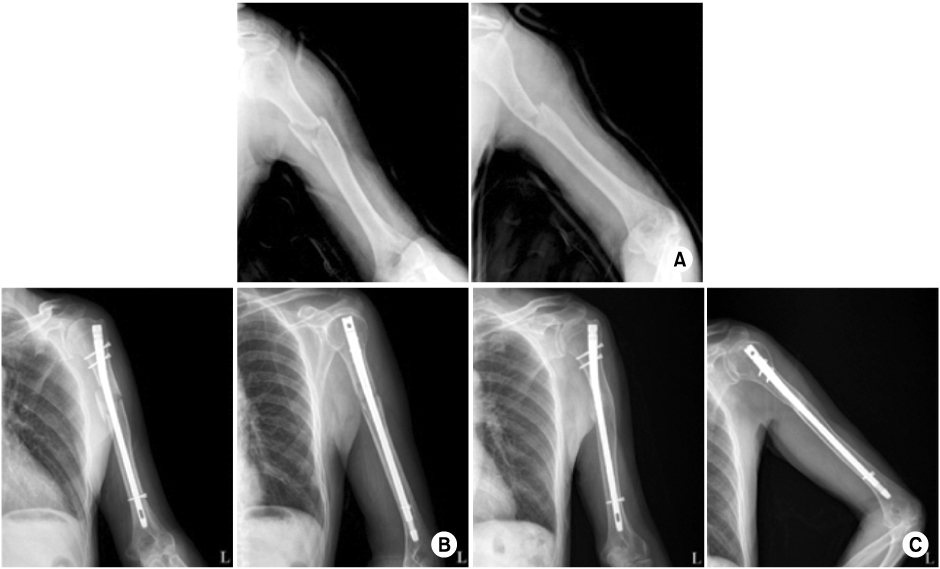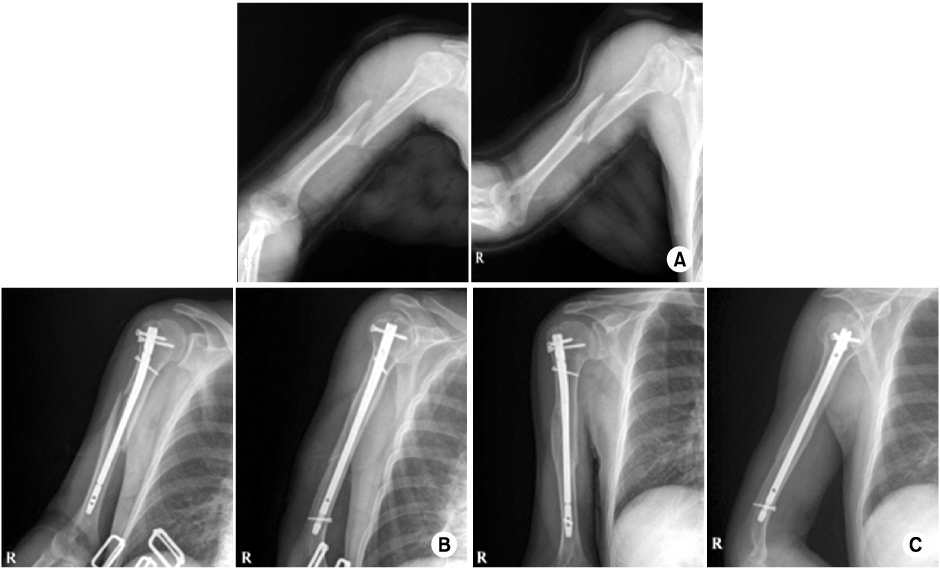J Korean Fract Soc.
2013 Jan;26(1):14-20. 10.12671/jkfs.2013.26.1.14.
Polarus Intramedullary Nail for Proximal Humeral and Humeral Shaft Fractures in Elderly Patients with Osteoporosis
- Affiliations
-
- 1Department of Orthopaedic Surgery, Baptist Hospital, Busan, Korea. promenade20@naver.com
- KMID: 1431711
- DOI: http://doi.org/10.12671/jkfs.2013.26.1.14
Abstract
- PURPOSE
To assess the effectiveness of optimal treatment of proximal humeral fractures and humeral shaft fractures in elderly patients with osteoporosis using the Polarus nail.
MATERIALS AND METHODS
Twenty-three patients with proximal humeral and humeral shaft fractures in elderly osteoporosis patients were treated using the Polarus intramedullary nail. Nine patients had proximal humeral fracture, 10 had humeral shaft fracture and 4 had the proximal humeral frac-ture extended diaphyseally. Radiological outcomes included the bone-union and the degree of re-sidual deformity. The residual deformities of the proximal humerus were assessed by the neck-shaft angle and the shaft angulation. Clinical outcome was assessed with the American Shoulder and Elbow Surgeons (ASES) score.
RESULTS
All cases had bony union and the mean union period was 16.5 weeks. The average neck/shaft alignment at the time of bone union was 135degrees and varus deformities of neck-shaft angle was not seen in all patients. Varus shaft angulation was seen in 5 patients. The mean ASES score after surgery was 86.7 points.
CONCLUSION
The Polarus intramedullary nail is effective for the treatment of proximal humeral and humeral shaft fractures in elderly patients with osteoporosis because it not only enables early postoperative mobilization, but also obtains bone-union without avascular necrosis and nonunion.
Keyword
MeSH Terms
Figure
Reference
-
1. Adedapo AO, Ikpeme JO. The results of internal fixation of three- and four-part proximal humeral fractures with the Polarus nail. Injury. 2001. 32:115–121.
Article2. Agel J, Jones CB, Sanzone AG, Camuso M, Henley MB. Treatment of proximal humeral fractures with Polarus nail fixation. J Shoulder Elbow Surg. 2004. 13:191–195.
Article3. Bhandari M, Devereaux PL, McKee MD, Schemitsch EH. Compression plating versus intramedullary nailing of humeral shaft fractures--a meta-analysis. Acta Orthop. 2006. 77:279–284.
Article4. Brumback RJ. The rationales of interlocking nailing of the femur, tibia, and humerus. Clin Orthop Relat Res. 1996. (324):292–320.
Article5. Brumback RJ, Bosse MJ, Poka A, Burgess AR. Intramedullary stabilization of humeral shaft fractures in patients with multiple trauma. J Bone Joint Surg Am. 1986. 68:960–970.
Article6. Changulani M, Jain UK, Keswani T. Comparison of the use of the humerus intramedullary nail and dynamic compression plate for the management of diaphyseal fractures of the humerus. A randomised controlled study. Int Orthop. 2007. 31:391–395.
Article7. Chapman JR, Henley MB, Agel J, Benca PJ. Randomized prospective study of humeral shaft fracture fixation: intramedullary nails versus plates. J Orthop Trauma. 2000. 14:162–166.
Article8. Court-Brown CM, Caesar B. Epidemiology of adult fractures: A review. Injury. 2006. 37:691–697.
Article9. Dabezies EJ, Banta CJ 2nd, Murphy CP, d'Ambrosia RD. Plate fixation of the humeral shaft for acute fractures, with and without radial nerve injuries. J Orthop Trauma. 1992. 6:10–13.10. Füchtmeier B, May R, Hente R, et al. Proximal humerus fractures: a comparative biomechanical analysis of intra and extramedullary implants. Arch Orthop Trauma Surg. 2007. 127:441–447.
Article11. Garnavos C, Lasanianos N. Intramedullary nailing of combined/extended fractures of the humeral head and shaft. J Orthop Trauma. 2010. 24:199–206.
Article12. Halder SC, Chapman JA, Choudhury G, Wallace WA. Retrograde fixation of fractures of the neck and shaft of the humerus with the 'Halder humeral nail'. Injury. 2001. 32:695–703.
Article13. Hartsock LA, Estes WJ, Murray CA, Friedman RJ. Shoulder hemiarthroplasty for proximal humeral fractures. Orthop Clin North Am. 1998. 29:467–475.
Article14. Hepp P, Lill H, Bail H, et al. Where should implants be anchored in the humeral head? Clin Orthop Relat Res. 2003. (415):139–147.
Article15. Ingman AM, Waters DA. Locked intramedullary nailing of humeral shaft fractures. Implant design, surgical technique, and clinical results. J Bone Joint Surg Br. 1994. 76:23–29.
Article16. Instrum K, Fennell C, Shrive N, Damson E, Sonnabend D, Hollinshead R. Semitubular blade plate fixation in proximal humeral fractures: a biomechanical study in a cadaveric model. J Shoulder Elbow Surg. 1998. 7:462–466.
Article17. Lee HJ, Oh CW. Operative treatment of humerus shaft fracture: conventional open plating or minimally invasive plate osteosynthesis. J Korean Fract Soc. 2012. 25:155–162.
Article18. Levy B, Herrera D, Templeman D, Cole P. Segmental proximal humerus fractures: a case report of submuscular plating. J Trauma. 2008. 65:1554–1557.
Article19. Lin J. Treatment of humeral shaft fractures with humeral locked nail and comparison with plate fixation. J Trauma. 1998. 44:859–864.
Article20. Lin J, Hou SM. Locked nailing of severely comminuted or segmental humeral fractures. Clin Orthop Relat Res. 2003. (406):195–204.
Article21. Lin J, Hou SM, Inoue N, Chao EY, Hang YS. Anatomic considerations of locked humeral nailing. Clin Orthop Relat Res. 1999. (368):247–254.
Article22. McCormack RG, Brien D, Buckley RE, McKee MD, Powell J, Schemitsch EH. Fixation of fractures of the shaft of the humerus by dynamic compression plate or intramedullary nail. A prospective, randomised trial. J Bone Joint Surg Br. 2000. 82:336–339.23. Meekers FS, Broos PL. Operative treatment of humeral shaft fractures. The Leuven experience. Acta Orthop Belg. 2002. 68:462–470.24. Neer CS 2nd. Displaced proximal humeral fractures. I. Classification and evaluation. J Bone Joint Surg Am. 1970. 52:1077–1089.25. Noh KC, Chung YK, Chung KJ, Hong SK. Two-part and three-part fractures of the proximal humerus treated with the Polarus interlocking nail: a comparison of fracture types. J Korean Fract Soc. 2006. 19:182–187.
Article26. Oh HK, Choo SK, Lee JI, Seo DH. Minimally invasive plate osteosynthesis for humeral proximal or distal shaft fractures using a 3.5/5.0 metaphyseal locking plate. J Korean Fract Soc. 2012. 25:305–309.
Article27. Oh JH, Kim YH. The current concepts in the treatment of proximal humerus fracture. J Korean Fract Soc. 2012. 25:94–104.
Article28. Palvanen M, Kannus P, Niemi S, Parkkari J. Update in the epidemiology of proximal humeral fractures. Clin Orthop Relat Res. 2006. 442:87–92.
Article29. Park JY, Oh JH, Kho DH, Jung JK. Intramedullary nail on the humeral fracture. J Korean Fract Soc. 2008. 21:244–254.
Article30. Park TS, Lee JH, Kim TS, Lee KH, Park KC. Contributing factors of radial nerve palsy associated with humeral shaft fracture. J Korean Fract Soc. 2008. 21:292–296.
Article31. Rancan M, Dietrich M, Lamdark T, Can U, Platz A. Minimal invasive long PHILOS®-plate osteosynthesis in metadiaphyseal fractures of the proximal humerus. Injury. 2010. 41:1277–1283.
Article32. Ruch DS, Glisson RR, Marr AW, Russell GB, Nunley JA. Fixation of three-part proximal humeral fractures: a biomechanical evaluation. J Orthop Trauma. 2000. 14:36–40.
Article33. Sosef N, Stobbe I, Hogervorst M, et al. The Polarus intramedullary nail for proximal humeral fractures: outcome in 28 patients followed for 1 year. Acta Orthop. 2007. 78:436–441.
Article34. Sturzenegger M, Fornaro E, Jakob RP. Results of surgical treatment of multifragmented fractures of the humeral head. Arch Orthop Trauma Surg. 1982. 100:249–259.
Article35. Verbruggen JP, Stapert JW. Humeral fractures in the elderly: treatment with a reamed intramedullary locking nail. Injury. 2007. 38:945–953.
Article36. Watanabe RS. Intramedullary fixation of complicated fractures of the humeral shaft. Clin Orthop Relat Res. 1993. (292):255–263.
Article37. Weise K, Grosse B, Hoffmann J, Sauer N. Results of treatment of 475 second- and third-degree open fractures of long tubular bones (1974-1988). Aktuelle Traumatol. 1993. 23:Suppl 1. 2–20.38. Yang KH. Helical plate fixation for treatment of comminuted fractures of the proximal and middle one-third of the humerus. Injury. 2005. 36:75–80.
Article39. Young TB, Wallace WA. Conservative treatment of fractures and fracture-dislocations of the upper end of the humerus. J Bone Joint Surg Br. 1985. 67:373–377.
Article40. Zyto K, Wallace WA, Frostick SP, Preston BJ. Outcome after hemiarthroplasty for three- and four-part fractures of the proximal humerus. J Shoulder Elbow Surg. 1998. 7:85–89.
Article
- Full Text Links
- Actions
-
Cited
- CITED
-
- Close
- Share
- Similar articles
-
- A Comparative Study on Internal Fixation Using Long Proximal Intramedullary Nail for the Treatment of Humeral Shaft Fracture according to Fracture Types
- Comparing the Use of Single and Double Interlocking Distal Screws on a Polarus Intramedullary Nail for Humeral Shaft Fractures
- Operative Treatment in Fractures of the Humeral Shaft: Comparison of the Clinical Results of Flexible Intramedullary Nailing Versus Interlocking Intramedullary Nailing
- Closed Locked Intramedullary Nailing for Humeral Shaft Fractures
- Treatment of Humeral Shaft Fracture with AO Unreamed Humeral Nail



